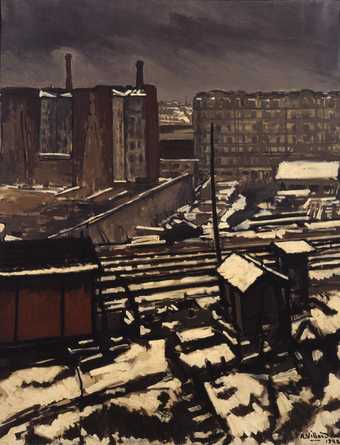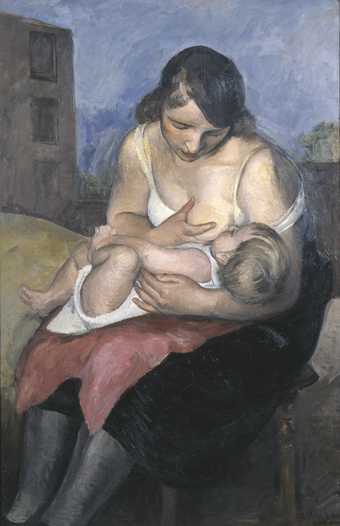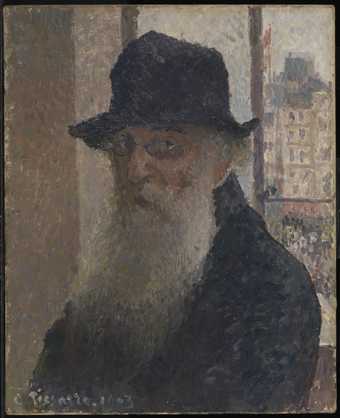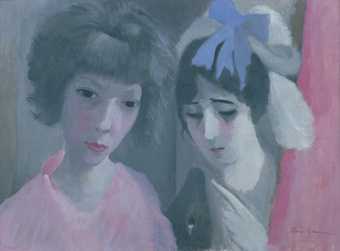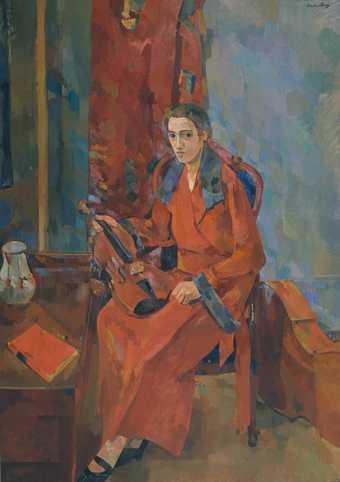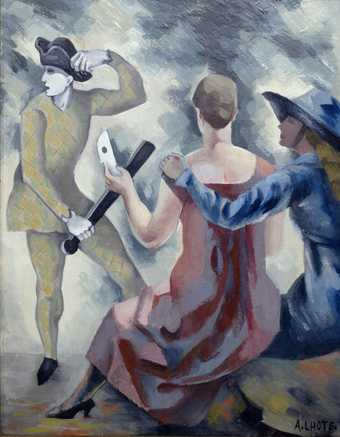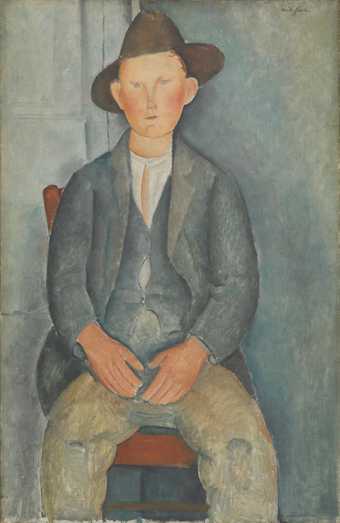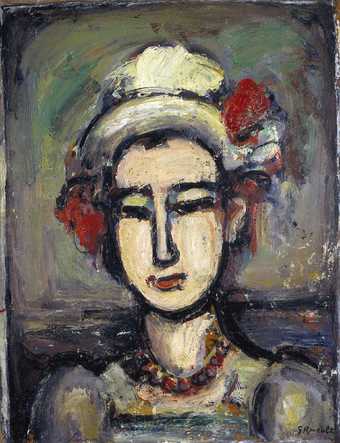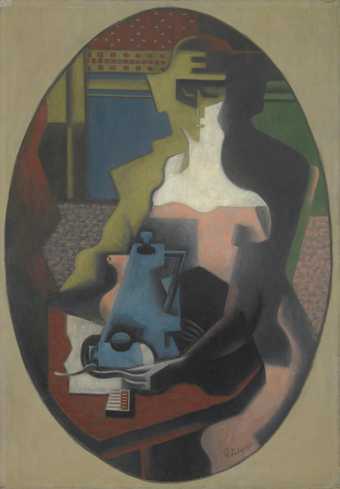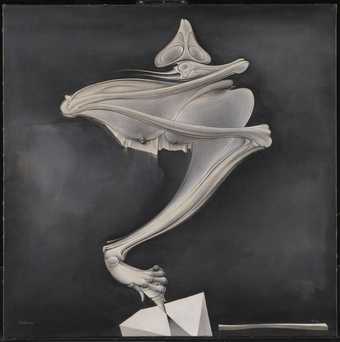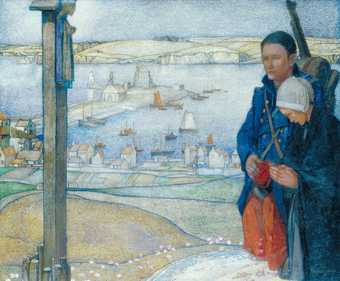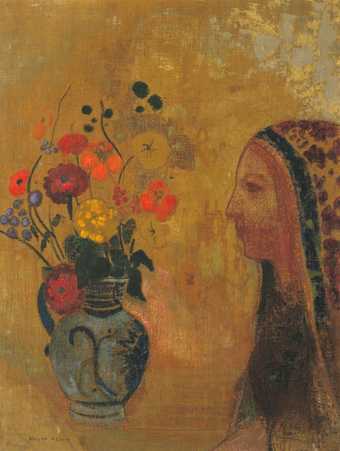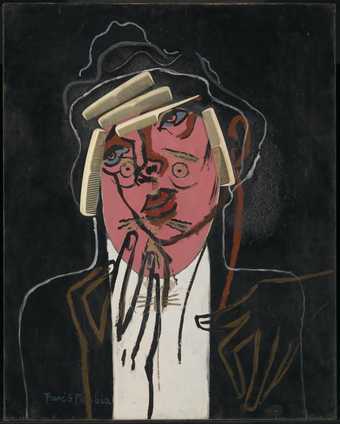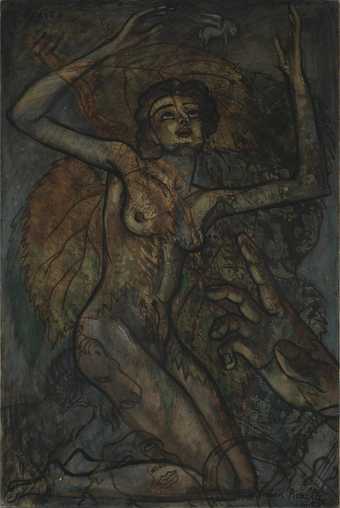
On loan
Nasjonalmuseet (Oslo, Norway): Louise Bourgeois: Imaginary Conversations
- Artist
- Marie Laurencin 1885–1956
- Original title
- L'Eventail
- Medium
- Oil paint on canvas
- Dimensions
- Support: 305 × 300 mm
frame: 440 × 435 × 46 mm - Collection
- Tate
- Acquisition
- Bequeathed by Elly Kahnweiler 1991, accessioned 1994
- Reference
- T06805
Summary
The Fan is painted in Marie Laurencin’s typically restrained palette of blue, rose and grey. It depicts two women staring at the viewer from two frames on a table. It has been suggested that the woman in the oval frame is the artist herself. The identification of the other, however, is uncertain. She may simply be a model holding Laurencin’s little black dog Coco, or she may represent the idea of a loved one the artist was missing as she sojourned in Spain as an exile during the First World War. This may have been the dressmaker Nicole Groult. Laurencin had met her in 1911 and they are said to have been lovers at some point in the following years. The image is intriguingly ambiguous. The frames may represent a mirror or a picture within a picture, while the fan, which was a symbol of vanity and one of Laurencin’s favourite accessories, may indicate the presence of another person in the room.
Until the 1930s Laurencin was fêted as a member of avant-garde circles and fashionable Parisian society, and her work and artistic identity were seen as exquisitely feminine. In his 1921 critical study of the artist, Marie Laurencin et son oeuvre, the poet Roger Allard described her as ‘undoubtedly the most celebrated woman artist of today’, and wrote of her work as being coquettish and narcissistic, ‘Her art is selfish and charming and ... compares everything to itself ... Having no fondness except for any objects or forms of nature that resemble her ... Marie Laurencin only questions nature and life in order to find more urgent and unforeseen reasons to love herself.’ (Allard, Paris 1921, pp.6-7.)
From the end of the 1930s Laurencin’s work was less highly regarded until a resurgence of interest in the 1980s. A catalogue raisonné of her engraved work published in 1981 was followed in 1983 by the inauguration of the Marie Laurencin Museum in Nagano-Ken, Japan, and by a catalogue raisonné of her paintings in 1986. Moreover, her work and sexual identity were rediscovered by feminist art historians, who propounded alternative readings of her work. Eschewing the discussions of grace and femininity of earlier theorists, some of the latest Laurencin studies underline the importance of her sexual identity within her art. She was credited by one commentator as having created ‘a visual language of female creativity and lesbian desire in early twentieth-century Paris’. (Otto 2002) In a study of a number of early Laurencin’s self-portraits, art historian Elizabeth Kahn has described her as ‘a young woman in the process of negotiating her way out of conventional femininities’, adding ‘she seemed to be searching for a unique identity that could resist the historic control of the male viewer.’ (Kahn 2003, p.xvii.)
Further reading:
Elizabeth Otto, ‘Memories of Bilitis: Marie Laurencin beyond the Cubist Context’, Genders Online Journal, no.36, 2002, http://www.genders.org/g36/g36_otto.html
Elizabeth Louise Kahn, Marie Laurencin: Une femme inadaptée in Feminist Histories of Art, Aldershot 2003
Giorgia Bottinelli, ‘Marie Laurencin’, in Jennifer Mundy (ed.), Cubism and its Legacy: The Gift of Gustav and Elly Kahnweiler, exhibition catalogue, Tate Modern, London 2004, pp.56-8, reproduced p.58 in colour
Giorgia Bottinelli
March 2004
Does this text contain inaccurate information or language that you feel we should improve or change? We would like to hear from you.
Display caption
The Fan was Elly Kahnweiler’s personal property and is thought to have been Gustav’s wedding present to her. It has been suggested that the woman in the oval frame is the artist herself. The identification of the other, however, is uncertain. The image is intriguingly ambiguous: the frames, for example, may represent mirrors, or pictures within the picture. The fan, which was a symbol of vanity and one of Laurencin’s favourite accessories, may indicate the presence of another person in the room.
Gallery label, May 2004
Does this text contain inaccurate information or language that you feel we should improve or change? We would like to hear from you.
Technique and condition
The painting was executed in oil colours on a single piece of linen canvas which is glued to a piece of 5mm thick board. There are pin holes visible in the canvas along the top and right edges, which suggests it was attached to a different secondary support during the application of paint. At some point after the painting had been completed, the canvas was cut down and adhered to the board. The canvas was cut quite unevenly which is particularly noticeable at the bottom right corner, where the board is visible even when the painting is framed. It is possible that this was carried out by the artist herself, although this is not known for sure. The signature in the top left corner appears to be original which might suggest this cropping was original. The canvas was probably first sized with a thin unpigmented layer of animal glue, followed by a white oil priming over which the paint was then applied. The ground is of reasonable thickness and the texture of the canvas weave is still apparent through it.
The paint was applied by brush in a fairly loose manner, mainly in thin layers, although the brushstrokes in the fan and sitter's face have an appreciable thickness. The painting had been varnished, probably with a natural resin, as part of an earlier restoration. There were also a number of far more discoloured areas on the paintings surface (i.e. beneath the varnish) which were probably remnants of an older and original varnish (although it is also possible that they were medium-rich retouchings). Either way, the degree of discoloration was considered disturbing to the painting. The varnish and discoloured regions were therefore removed and a clear and stable synthetic varnish was applied.
It is not known whether the frame is original. The painting is in overall good condition. The canvas and board support have remained structurally sound and the only damage to the paint layers has been some minor wear. The area of missing canvas in the bottom right corner has been retouched to mimic more closely the surrounding paint colour.
Tom Learner
September 1997
Explore
- objects(23,571)
-
- clothing and personal items(5,879)
-
- fan(67)
- furnishings(3,081)
-
- mirror(241)
- head / face(2,497)
You might like
-
Antoine Villard Circuit Railway at Grenelle
1922 -
Jean Marchand Maternity
1921 -
Camille Pissarro Self-Portrait
1903 -
Marie Laurencin Portraits (Marie Laurencin, Cecilia de Madrazo and the Dog Coco)
1915 -
Simon Levy The Musician
1925 -
André Lhote Study for ‘Homage to Watteau’
1918 -
Amedeo Modigliani The Little Peasant
c.1918 -
Georges Rouault The Italian Woman
1938 -
Jean Marchand Angelina
1923 -
Jean Metzinger Woman with a Coffee Pot
1919 -
Hans Bellmer Peg-Top
c.1937–52 -
Edward Reginald Frampton Brittany: 1914
c.1920 -
Odilon Redon Profile of a Woman with a Vase of Flowers
c.1895–1905 -
Francis Picabia The Handsome Pork-Butcher
c.1924–6, c.1929–35 -
Francis Picabia Otaïti
1930

